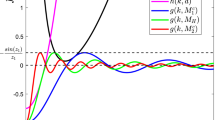Abstract
Ratio-dependent predator-prey models are increasingly favored by both the theoretical and experimental ecologists as a more suitable alternative to describe predator-prey interactions when the predators hunt seriously. In this article, the classical Bazykin’s model is modified with ratio-dependent functional response. Stability and bifurcation situations of the system are observed. Since the ratio-dependent model always has difficult dynamics in the vicinity of the origin, the analytical behavior of the system near origin is studied completely. It is found that paradox of enrichment can happen to this system under certain parameter values, although the functional response is ratio-dependent. The parametric space for Turing spatial structure is determined. We also conclude that competition among the predator population might be beneficial for predator species under certain circumstances. Finally, ecological interpretations of our results are presented in the discussion section.
Similar content being viewed by others
References
Abrams, P.A., 1994. The fallacies of ‘Ratio-dependent’ predation. Ecology 75(6), 1842–1850.
Akcakaya, H.R., Arditi, R., Gingburg, L.R., 1995. Ratio-dependent predation: an abstraction that works. Ecology 76, 995–1004.
Alekseev, V.V., 1973. Effect of saturation factor on dynamics of predator prey system. Biofizika 18, 922–926.
Alonso, D., Bartumeus, F., Catalan, J., 2002. Mutual interference between predators can give rise to Turing spatial Patterns. Ecology 83(1), 28–34.
Arditi, R., Ginzburg, L.R., 1989. Coupling in predator-prey dynamics: ratio-dependence. J. Theor. Biol. 139, 311–326.
Arino, O., Mikram, J., Chattopadhyay, J., 2004. Infection on prey population may act as a biological control in ratio-dependent predator-prey model. Nonlinearity 17, 1101–1116.
Bazykin, A.D., 1998. Nonlinear Dynamics of Interacting Populations. Series on Nonlinear Science. Ser. A, vol. 11. World Scientific, Singapore. Chua, L.O. (Ed.), Original Russian version: Bazykin, A.D. Nauka, Moscow (1985).
Berezovskaya, F., Karev, G., Arditi, R., 2001. Parametric analysis of ratio-dependent predator-prey model. J. Math. Biol. 43, 221–246.
Cosner, C., Angelis, D.L., Ault, J.S., Olson, D.B., 1999. Effects of spatial grouping on the functional response of predators. Theor. Popul. Biol. 56, 65–75.
Freedman, H.I., 1980. Deterministic Mathematical Method in Population Ecology. Dekker, New York.
Getz, W.M., 1984. Population dynamics-a per capita resource approach. J. Theor. Biol. 108, 623–643.
Greenhalgh, D., Haque, M., 2007. A predator-prey model with disease in the prey species only. Math. Methods Appl. Sci. 30, 911–929.
Gutierrez, A.P., 1992. The physiological basis of ratio-dependent predator-prey theory: a metabolic pool model of Nicholson’s blowflies as an example. Ecology 73, 1552–1563.
Hale, J., 1969. Ordinary Differential Equations. Wiley-Interscience, New York.
Hanski, I., 1991. The functional response of predator: worries about scale. TREE 6, 141–142.
Haque, M., Venturino, E., 2007. An eco-epidemiological model with disease in predator: the ratio-dependent case. Math. Methods Appl. Sci. 30, 1791–1809.
Hsu, S.B., Hwang, T.W., Kuang, Y., 2001a. Rich dynamics of ratio-dependent one prey two predators model. J. Math. Biol. 43, 377–396.
Hsu, S.B., Hwang, T.W., Kuang, Y., 2001b. Global analysis of the Michaelis Menten type ratio-dependent predator-prey system. J. Math. Biol. 42, 489–506.
Hsu, S.B., Hwang, T.W., Kuang, Y., 2003. A ratio-dependent food chain model and its application to biological control. Math. Biosci. 181, 55–83.
Jost, C., Arditi, R., 2000. Identifying predator-prey process from time series. Theor. Popul. Biol. 57, 325–337.
Jost, C., Arino, O., Arditi, R., 1999. About deterministic extinction in ratio-dependent predator-prey models. Bull. Math. Biol. 61, 19–32.
Kuang, Y., 1999. Rich dynamics of Gause-type ratio-dependent predator-prey system. Fields Inst. Commun. 21, 325–337.
Kuang, Y., Bertta, E., 1998. Global qualitative analysis of a ratio-dependent predator-prey system. J. Math. Biol. 36, 389–406.
Luckinbill, L.S., 1973. Coexistence in laboratory populations of Paramecium Aurelia and its predator Didinium nasutum. Ecology 54, 1320–1327.
May, R.M., 1974. Stability and Complexity in Model Eco-System. Princeton University Press, Princeton.
Murray, J.D., 1989. Mathematical Biology. Biomathematics, vol. 19. Springer, Berlin.
Tanner, J.T., 1975. The stability and intrinsic growth rates of prey and predator populations. Ecology 56, 855–867.
Thieme, H., 1997. Mathematical Biology. An Introduction via Selected Topics. Lecture Note at Arizona State University.
Sotomayor, J., 1973. Generic bifurcation of dynamical systems. In: Peixoto, M.M. (Ed.), Dynamical System. Academic Press, San Diego.
Xiao, D., Ruan, S., 2001. Global dynamics of ratio-dependent predator-prey system. J. Math. Biol. 43, 268.
Xiao, Y., Chen, L., 2002. A ratio-dependent predator-prey model with disease in the prey. Appl. Math. Comput. Arch. 131, 397–414.
Author information
Authors and Affiliations
Corresponding author
Rights and permissions
About this article
Cite this article
Haque, M. Ratio-Dependent Predator-Prey Models of Interacting Populations. Bull. Math. Biol. 71, 430–452 (2009). https://doi.org/10.1007/s11538-008-9368-4
Received:
Accepted:
Published:
Issue Date:
DOI: https://doi.org/10.1007/s11538-008-9368-4




